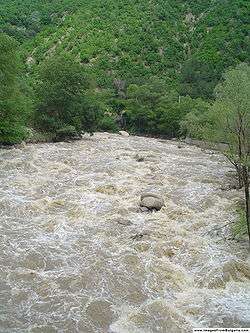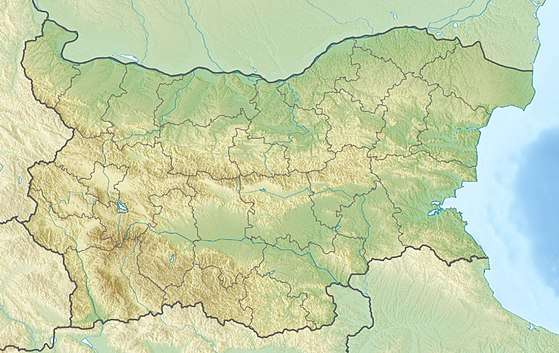Kresna Gorge
| Kresna Gorge | |
|---|---|
| Кресненско дефиле | |
 Struma River in Kresna Gorge | |
 Kresna Gorge Location within Bulgaria | |
| Location | Pirin and Maleshevo mountain ranges, Bulgaria |
| Floor elevation | 222 m (728 ft) |
| Long-axis direction | north to south |
| Long-axis length | 18 kilometres (59,000 ft) |
| Geology | |
| Type | Gorge |
| Geography | |
| Coordinates | 41°46′7″N 23°9′18″E / 41.76861°N 23.15500°ECoordinates: 41°46′7″N 23°9′18″E / 41.76861°N 23.15500°E |
Kresna Gorge (Bulgarian: Кресненско дефиле) is a steep valley in south-western Bulgaria, stretching about 18 km. The gorge has been formed by the Struma River, which flows from the Vitosha mountains. Kresna gorge has a rich biodiversity, which has come under pressure from the Struma motorway construction project, a new leg of the Trans European Corridor No. 4.[1][2] In the south, the gorge bisects in two Tisata nature reserve.
Kresna Gorge was the place of the Battle of Kresna Gorge between Bulgaria and Greece during the 1913 Second Balkan War. The Greek army was threatened by encirclement in the valley, but due to the Romanian army advancing against the undefended capital Sofia, Bulgaria had to agree to an armistice and the resulting peace treaty in Bucharest which was unfavorable to Bulgaria's territorial aspirations.[3]
Terrain and Climate
Kresna Gorge is situated near the villages of Palat, Drakata, and Krupnik while surrounded by the Pirin and Maleshevska Mountains. The gorge is a transitory Mediterranean climate, as it is located between the Central-European and Mediterranean climate zones. The Struma River cuts through the gorge and is a main geological feature. Near the riverbank are sediment soils which transition into shallow alluvial soil with maroon soil on the side.[4] The rocky terrain varies throughout the gorge, including stony slopes, large vertical cliffs, and small rocky sections.
Ecology
Kresna Gorge is inhabited with diverse fauna and flora, as well as a ranging terrain. The southern reaches of the gorge bisect in two Tisata nature reserve. The gorge is home to multiple Mediterranean plants, vegetation, landscapes and bird wildlife.[5] There are approximately 31 species of reptiles, 75 species of mammals, and 232 species of birds in this slightly small gorge.[6] The gorge is considered a Natura 2000 conservation site, signifying its importance in the lives of endangered species that rely on the gorge. Birds, such as cormorants, that may not settle down in the gorge itself still utilize its resources as passageways and migration stops. The resources that the gorge provides are crucial, and serve as the main resting sites to threatened and rare species such as the Egyptian vulture. [7]
There are multiple types of forests located inside this gorge; these forests include different types of oak trees such as Quercus pubescens, Carpinus orientalis, and Fraxinus ornus. Considering the climate, classic Mediterranean species of flora such as Quercus coccifera and Phillyrea thrive.[6] The magnitude of the vegetation and plant population in Kresna explains the large, varied populations of birds and other animals within the gorge.
Struma Motorway
The Struma motorway, a project that is part of The European Transport Corridor No IV, is planned to cut through the Kresna Gorge. The motorway is seen by the European Union, as well as the Bulgarian government, as a vital trade and tourism route, and receives funding from the European Investment Bank (EIB).[8] The motorway will provide a passageway from Germany and Hungary to Greece, and aims to boost the Bulgarian economy. The project, however, will also have some destructive effects for the inhabitants of the gorge and its ecosystem. With the current road in the gorge, lack of proper mitigation has already led to many road kills over the years; with the construction of the new motorway project, animal mortality rate is expected to increase, not just because of direct traffic accidents but also because of the effects of deforestation and habitat loss.[9]
The locals in the nearby villages are afraid their shops and livelihoods will be deserted when the motorway opens. They also fear that Kresna will attract fewer tourists and that young residents will migrate to other countries.[10] The motorway will force some of the villagers to lose land and property during the construction, negatively impacting their livelihoods.[10]
References
- ↑ "Struma Motorway". ebrd.com. Retrieved 2017-11-08.
- ↑ "LIFE for Kresna Gorge". rewildingeurope.com. Retrieved 2017-11-08.
- ↑ Balkan Wars 1912-1913 PDF; Page 12
- ↑ "Kresna Gorge". fwff.org. Retrieved 2017-11-08.
- ↑ "Five Threats to Nature". assets.panda.org. Retrieved 2017-11-08.
- 1 2 "Kresna Gorge". klooiplek.eu. Retrieved 2017-11-08.
- ↑ "Egyptian Vulture (Neophron percnopterus)". fwff.org. Retrieved 2017-11-08.
- ↑ "EU money should not help destroy Bulgaria's Kresna Gorge". euractiv.com. Retrieved 2017-11-08.
- ↑ "Struma Motorway Lot 3.2" (PDF). ncsip.bg. Retrieved 2017-11-08.
- 1 2 "Bulgarian motorway poised to carve up wildlife haven". theguardian.com. Retrieved 2017-11-08.